Dan Flavin (1933–96) was notoriously prickly about any attempts to interpret his fluorescent light installations. ‘There is no invitation to meditate, to contemplate,’ he once said. ‘Electric light is just another instrument. I have no desire to contrive fantasies mediumistically or sociologically over it or beyond it.’ Or, as he famously put it: ‘It is what it is and it ain’t nothing else.’
Ain’t it? An exhibition at the Kunstmuseum in Basel gently questions these refusenik notions by focusing on Flavin’s ‘dedications’: the fluorescent pieces he named after people, groups or events. The curators have plenty to choose from. There’s untitled (to Henry Matisse), from 1964, which comprises four vertical bars of light in pink, yellow, blue and green in homage to the painter’s bold use of colour. There are the ‘monuments’ dedicated to Vladimir Tatlin, the Russian constructivist whose thrusting architectural visions are honoured in Flavin’s rocket-shaped ‘monument’ 7 (1964). And there’s monument 4 for those who have been killed in ambush (1966), which once lit up the back room of the New York nightclub Max’s Kansas City in grim, sanguine red.
‘monument’ 7 for V. Tatlin (1964), Dan Flavin. Pinakothek der Moderne, Munich. Photo: Florian Holzherr; © Stephen Flavin/ProLitteris, Zurich, 2024

Though the show never feels less than polite and respectful toward its subject, one can sense the curators posing a series of questions. Why would an artist so reluctant to be analysed give his artworks such specific titles? Why would someone who wanted his work to exist as simply as possible devote so much energy to giving interviews about his art and writing about it in magazines? And why would he strive to divorce his work from any sociological context while being so clearly preoccupied with ongoing atrocities?
monument 4 is a work of simmering fury. Created as the United States was stepping up its involvement in the Vietnam War, it comprises four eight-foot-long red lights: two arranged horizontally on adjacent walls, meeting at the corner of the room; one conjoining them; and one protruding from the corner towards the centre of the room – towards the viewer, in other words. It resembles a crossbow, a tank turret, a fighter jet about to swoop overhead. In the same room is untitled (to the ‘last war’, the final one) 4, also from 1966. It is simpler but no less eloquent: a small green vertical light is topped with a much longer horizontal red beam at shin height – or coffin height. It brings to mind two meanings of the word ‘shoot’: one of growth, and one of violence.
monument 4 for those who have been killed in ambush (to P.K. who reminded me about death) (1966), Dan Flavin. Photo: Florian Holzherr; courtesy the Dan Flavin Estate/David Zwirner; © Stephen Flavin/ProLitteris, Zurich, 2024

Just as words can be equivocal, red light, in Flavin’s hands, can signify very different things. Here, the two anti-war works on display are joined in the same room by four red horizontals (to Sonja), from 1963 – a work that looks exactly as its title might suggest and is dedicated to his wife. Were one to ignore Flavin’s injunctions against meaning-mongering, one might see constancy, like-mindedness, bodies heading in the same direction. But though it brings home Flavin’s point about light of any colour being ‘just another instrument’, the display dilutes the force of the two angrier works nearby. The seething red beams of monument 4 are perhaps better suited to dingy nightclub back rooms; they seem neutered by the well-lit white cubes of the Kunstmuseum Neubau.
This Basel institution is nonetheless a fitting place for a Flavin retrospective. ‘Dedications in Lights’ is a staircase away from the museum’s post-1950s galleries, which feature works by minimalist artists such as Jasper Johns and Donald Judd – both dedicatees of works in the Flavin show. Flavin’s connections with Basel have deep roots: in 1975 he presented, in tandem, a show of his light installations at the Kunsthalle, just down the road, and an exhibition of his figurative drawings at the Kunstmuseum, which he complemented with selections from his own collection of drawings by the Swiss artist and mercenary Urs Graf (c. 1485–1528). The curators have tried to honour this history by more or less restaging this exhibition partway through the light show; some viewers may find this disjointed, though Graf’s vivid, rapid pen lines, in their directness, find unexpected harmony with Flavin’s fluorescent fittings. The artist’s untitled (in memory of Urs Graf) has been lighting up the Kunstmuseum courtyard for nearly 50 years.
untitled (in memory of Urs Graf) (1972/1975), Dan Flavin. Kunstmuseum Basel. Photo: Florian Holzherr; © Stephen Flavin/ProLitteris, Zurich, 2024

But this sense of homecoming might have inhibited the curators’ willingness to probe the idea of Flavin as a lone male genius. At the preview, co-curator Olga Osadtschy pointed out that Flavin’s late wife, Sonja, who was also an artist, was responsible for all the technical elements of his work, including the casings and the electrics. In some of Flavin’s other light work, not present in this exhibition, Sonja was in charge – to quote Osadtschy – of ‘anything that involved a hammer or a screwdriver’. The accompanying exhibition materials might have benefited from a little more information on Mrs Flavin’s creative role.
Still, there are many pleasures to be found throughout the show. Spend enough time in room 5, which is taken up entirely by a fluorescent green installation, and it soon seems to fade from emerald-hued to white; turn back to room 4, containing various works using white light, and the gallery now appears unaccountably fuchsia. Viewers who examine any of the brightly coloured bars while walking around them will see the reflections of the other beams morph and stretch on their surface. The full effects can only be felt in person.
untitled (to you, Heiner, with admiration and affection) (1973), Dan Flavin. Pinakothek der Moderne, Munich. Photo: Florian Holzherr; © Stephen Flavin/ProLitteris, Zurich, 2024

The exhibition’s most formally unusual work is untitled (to a man, George McGovern) 2, which went on display in 1972, just three days before the Democratic presidential candidate was trounced at the polls by Richard Nixon. It is the only piece to feature lights that are circular rather than linear. Upon its unveiling, this set of warm white roundels arranged in a large right-angled triangle must have seemed hopeful – a stairway to victory, an ascendant force borne aloft by a collective. But ever since, it has come to resemble a prophetic image of what actually came to pass on election day: a landslide. to a man is an embodiment of Flavin’s particular blend of optimism and irony, his oblique approach to the events of the day, and – despite his objections – the many possible readings of his work.
untitled (to a man, George McGovern) 2 (1972), Dan Flavin. Guggenheim Abu Dhabi. Photo: Florian Holzherr; © Stephen Flavin/ProLitteris, Zurich, 2024

‘Dan Flavin: Dedications in Lights’ is at the Kunstmuseum Basel until 18 August.



